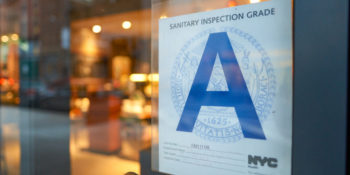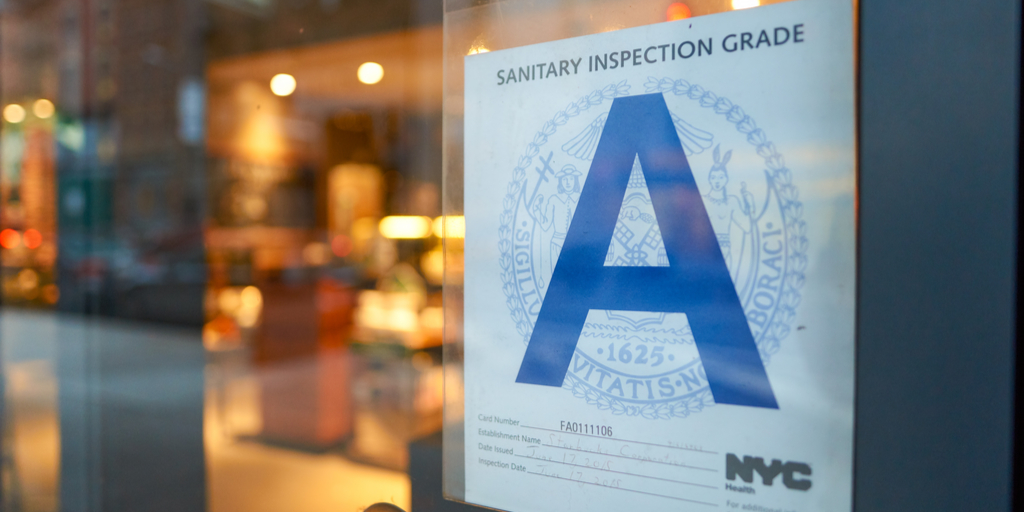Preventing foodborne illnesses in New York City’s restaurants is serious business, which is why the city implemented a grading system in 2010. Grading a restaurant A, B or C has become a highly visible standard of the culinary scene in NYC. However, not all New Yorkers understand what these grades mean or how they became a ubiquitous window decoration for the city’s dining spots. Nearly a decade since the system’s implementation, we revisit the creation of the grading system, unpack the meaning of each grade and explore the ways the city is working to enforce a cleaner, safer restaurant scene.
By Karen Asp
Outside of your kids’ (or your own) performance in school, grades are probably of little interest to you. The one exception, however, might be when you’re dining out in New York City and you can’t help noticing that sign in the front window displaying the letter A, B or C.
Restaurant grades are designed to be a communication tool, letting customers know how restaurants rank in terms of food safety, and that’s a good thing, given that every year 48 million Americans contract a foodborne illness and 3,000 die, according to the Centers for Disease Control and Prevention (CDC). But what do the grades really mean and is there any chance you can’t judge a book by its cover, so to speak?
From Non-Compliance to an Established System: How NYC’s Restaurant Grading System Got its Start
Although New York City’s health department has long inspected restaurants, it wasn’t until they began analyzing the data in the 2000s that the department realized there was a problem with the quality of services. “Most of the restaurants were performing in a mediocre way, in what we would now consider a B,” says Corinne Schiff, deputy commissioner of environmental health with the New York City Department of Health and Mental Hygiene (DOHMH).
In fact, restaurants were being closed back then on a regular basis. “Because we weren’t getting compliance; the system just wasn’t working,” says Christine Testa, a registered environmental health sanitarian with Food Safety Mentor in Brooklyn who in 2009 was assistant director at the DOHMH.
To correct those problems, the department turned to Los Angeles, which had introduced a restaurant grading program in 1998. After studying Los Angeles’s program, New York City launched its own grading system in July of 2010. Since then, food carts and trucks have been added to the program, and they got their first letter grades in January of 2019. The restaurant grading system gives consumers information to make smart choices about which restaurants are safe to eat in and which should be avoided because of unsanitary conditions. It also encourages restaurants to make the changes necessary to improve their rankings and encourage consumers to dine with them.
Grading NYC’s 24,000 Restaurants: The Fine Print of the System

All of the city’s restaurants are graded by one of the health department’s credentialed inspectors (there are currently 109), each of whom must have a bachelor’s degree and 30 credit hours in natural sciences. Once hired, they must complete a rigorous four-to-six-month training program that moves them from the classroom into the field, first shadowing senior inspectors and then being shadowed by those inspectors before going out on their own.
Inspectors are assigned to restaurants by a computer with emphasis placed on not sending the same inspectors back to the same restaurants. “We make sure the inspector and restaurant don’t have an opportunity to establish a relationship,” Schiff says. “While it’s possible they may visit the same restaurant twice in their career, it’s rare.”
On average, inspectors conduct two to three inspections a day — travel time is taken into account when assignments are made – and a typical inspection might take two to three hours, a process Testa describes as grueling. “Inspections are tense and stressful for both the inspector and the restaurant team, who can’t even offer the inspector a cup of coffee,” she says.
According to Jimmy Pelekanos, co-founder of Bareburger, it can also be a frustrating experience for diners, especially if the restaurant is busy. No food is prepared during the inspection, which can lead to delays in service.
At each restaurant, inspectors run through a lengthy checklist of requirements. “They’re evaluating five main categories of risk factors for foodborne illness as defined by the CDC,” Testa says. Those five categories include unapproved or unknown food sources, inadequate cooking temperatures, improper cold and hot holding temperatures, inadequate cleaning and sanitizing, and poor personal hygiene. Every violation is assigned to one of those categories.
If inspectors find any area of non-compliance, they assign points within each of the categories. “The number of points depends on the risk the violation poses to public health and the extent to which it’s found in the restaurant,” Schiff says. Points are handed out in three tiers of severity: Public health hazards, such as failing to keep food at the right temperature, receive a minimum of seven points; critical violations, such as serving a salad without washing it, a minimum of five points; and general violations, such as not properly sanitizing cooking utensils, two points minimum.
The more points a restaurant racks up, the lower its grade – and vice versa. An A-grade means that the restaurant has incurred 13 or fewer points. If a B-grade is assigned, it indicates that the restaurant has been given 14 to 27 points while a C-grade restaurant has racked up eat least 28 points (there is no maximum). Those grades also dictate how often a restaurant gets inspected. The city prioritizes C restaurants, inspecting them every three to four months, while Bs are inspected every four to six months and As every 10 to 12 months.
Although restaurants have a general idea when an inspection is due, they’re never announced in advance. Interestingly, a restaurant is given two chances to earn an A grade. If it doesn’t receive an A on the first inspection, an inspector will return unannounced, often within a month. If that second inspection earns a B or C, the restaurant can contest it, posting either its current grade or a “grade pending” card until a final decision is made. Customers who are curious about why a restaurant has a “grade pending” sign can visit the department’s website to learn more, including grades and reports for every New York City restaurant.
If, however, a restaurant has such severe violations that it fails to achieve even a C grade, it’s closed immediately. “This means we’ve spotted something that creates a public hazard that can’t be immediately corrected,” Schiff says. For instance, there could be a pest infestation, a fridge that’s gone out or sewage back-up. The health department then meets with the restaurant to review the issues and give guidance on reopening. Although this depends on the problem, it’s not uncommon for a restaurant to open 48 hours after being closed. “Restaurants typically work quickly to get back up and running,” she adds.
According to data obtained from a Freedom of Information Law (FOIL) request submitted by the Center to the NYC DOHMH, there were 26,902 restaurants subject to health department inspections by the city in 2018. That same year, there were 48,694 inspections (this includes reinspections) and 1,495 restaurants closed due to unsanitary conditions. On the other hand, there were 22, 136 restaurants with an A-grade as of December 31st, 2018.
Note that every new restaurant undergoes an initial inspection within three months of its opening, and if it doesn’t receive an A-grade, it isn’t graded at all, and the department generally returns in about a month for a reinspection. “The system was built to give restaurants more than a one-time shot and drive improvement as quickly as possible, as the department’s goal is that every restaurant achieve an A grade,” Schiff says, adding that the department provides technical assistance and a variety of educational programs to restaurant operators to help them learn how to comply with food safety requirements. “Restaurants can figure out where they need to improve, and a month gives them enough time to make corrections.”
How do restaurant owners and operators know what the rules and regulations are in NYC? The city has created a comprehensive blue book called “What to Inspect When You’re Inspected: A Guide for Food Service Operators.” Additionally, if you are a supervisor in a restaurant or non-retail food service establishment, you are required to obtain a City certification in food protection practices. To receive the certification, supervisors must take a free online course or pay to take the course in person.
How Well is the Grading System Working?

To date, the grading system has proved to be effective. Shortly after its inception, one survey found that fewer restaurants had violations related to foodborne illnesses, a trend that’s still holding. More than 90 percent of the city’s restaurants are posting A grades.
Maintaining – or in some cases, improving – their grade requires daily work for restaurants. According to Pelekanos of Bareburger, which has an A grade at all its locations, “We have a daily checklist specific to food handling and temperatures that must be followed, and the general manager of each restaurant is constantly looking for any potential or critical violations.” He adds that the staff is trained to act as if a health inspection were occurring daily.
But Bareburger doesn’t stop at the city-run inspections. Every quarter, the chain hires an independent auditor to conduct mock inspections at 27 of its locations in the tri-state area that are graded like a real health inspection. “Because the laws are constantly changing, we can’t keep up, so it’s great to have another set of eyes, especially from somebody with so much experience with the [DOHMH] and its codes,” Pelekanos says. Mock inspections also keep restaurant workers and managers on their toes.
Ensuring Honesty and Fairness Within the Grading System
No system is above reproach, and one of the obvious questions is how honest the system is. even though inspectors aren’t supposed to develop relationships with the restaurants they inspect, might there be a danger of favoritism, perhaps even overlooking harmless minor violations?
The resounding answer is no. “I can say with great confidence that inspectors don’t participate in anything shady or are in any way corrupt,” Testa says. “Everybody knows what’s at stake, and nobody’s going to take risks to jeopardize their career as an inspector or their future as a restaurant.”
As an example, during her time at the DOHMH, Testa remembers closing a famous Italian bakery right before Christmas Eve. A politician who caught wind of the closing tried to pressure the department into allowing it to reopen, but to no avail. “They had mouse droppings, which meant no way could it reopen,” she says.
Schiff also denies that there may be favoritism, even among chain restaurants, which undoubtedly have a larger footprint in the restaurant landscape. “Chain restaurants are held to the same standards as every other restaurant and receive no special treatment,” she says.
Still, it’s not out of the question that some restaurants may be falling through the cracks. “There aren’t enough inspectors, and while restaurants at high risk are inspected frequently, others that have posted A grades consistently might be put off a little while,” Testa says, adding that there’s a high turnover in inspectors because of the stress and the difficult nature of the job, which includes inspecting no matter the weather. “This job isn’t about making friends but protecting public health, and the sad fact is that inspectors don’t get the respect they deserve or appreciation for the knowledge they have.”
How Restaurants Navigate a “Grade Pending” Status
 In 2016, several local news stations reported that restaurants were keeping their “grade pending” sign in their window even after they’d lost their appeal, and there’s some suspicion this may still be happening today. “So many restaurants have ‘grade pending,’ and I don’t understand how there can be that many,” says Aziza Abouzaid, catering manager for Cowgirl Catering and Omar’s Mediterranean Cuisine.
In 2016, several local news stations reported that restaurants were keeping their “grade pending” sign in their window even after they’d lost their appeal, and there’s some suspicion this may still be happening today. “So many restaurants have ‘grade pending,’ and I don’t understand how there can be that many,” says Aziza Abouzaid, catering manager for Cowgirl Catering and Omar’s Mediterranean Cuisine.
Yet Schiff says that the department does inspect for compliance with grade-posting requirements. If restaurants aren’t posting the letter grade or “grade pending” sign, they could be fined.
Meanwhile, on the flip side, restaurants have issues with elements of the grading system, the first being the number of violations. “Although the system is warranted, there are so many violations that it’s almost impossible not to get hit with at least one, which is why some in the industry have called it a secret tax for the city,” Pelekanos says.
For example, if the individual who holds the restaurant’s food handling license steps outside for a minute during its hours of operation, and the inspector happens to arrive, the restaurant could be given 10 points if that person doesn’t return within 10 minutes. Flies in the restaurant are another example. Charges are doled out per fly, which makes Pelekanos wonder, “How can somebody count flies and be sure they’re not just counting the same fly?”
Restaurants also have to contend with inspections that are not always consistent. “If you get two inspections back-to-back, you might get two completely different inspections,” Abouzaid says. “Two inspectors can look at the same thing and react differently, which confuses restaurants.” For instance, Pelekanos recalls an inspector giving Bareburger a violation for something that had been inspected many times before without any violation.
Raising Awareness for NYC Diners

In the end, though, these grades are not only keeping diners safe but also making them aware of food safety. According to a 2012 survey of 511 adult New Yorkers conducted by Baruch College Survey Research, 88 percent say the grades factor into their dining decision.
So does that mean diners should choose only A restaurants and skip the B and C eateries? Absolutely not. “When you see a C grade, it means the restaurant doesn’t have active managerial control and the staff needs more training, which is why it’s gotten significant violations resulting in a C grade,” Testa says, adding that if you’re concerned, you can check the department’s website to see what the violations are. She’s eaten at restaurants of all grades and suggests that A doesn’t always add up to being the best. “I’ve walked out of A restaurants shaking my head.”
While it is important to use the restaurant grading system to guide your dining choices, diners should also use their intuition and gut. “If you pop your head into a restaurant and it’s a dump, don’t go there,” Abouzaid says. Fortunately, in a city with 24,000 restaurants, you won’t have to go far to find another option.
Learn more about NYC’s restaurant grading system here or explore our list of resources below.
Read about restaurant grading in the news and media
Letter grades for restaurants helped reduce Salmonella illnesses in New York City (Food Safety News)
More New York City Restaurants Have ‘A’ Grades Than Ever Before (Grub Street)
Most Restaurants Ace Their Health Inspections, but a Few Still Get Unsavory Grades (Wall Street Journal)
New York Restaurant Inspections by the Numbers (New York Times)
‘Recipe for Disaster’: New York State Comptroller’s Office Says Majority of Eateries with Serious Food Safety Violations Avoid Enforcement Actions (Daily News)
New York City Restaurants Aren’t as Gross as They Used to Be (Food and Wine)
New York City Food Carts Get Their First Report Cards (New York Times)
The Life of a Restaurant Inspector: Rising Grades, Fainting Owners (New York Times)
Search inventories of restaurants and their grades
New York Health Department Restaurant Ratings Map (New York Times)
New York City Restaurant Inspection Results (DOHMH)
NYC Restaurant Health Scores, Interpreted (The Eater)
Restaurant Grades (NYC Open Data)
Research restaurant grading through academic articles and journals
A structural equation model of New York restaurant grades over a 2-year period (Journal of Foodservice and Business Research)
Fudging the Nudge: Information Disclosure and Restaurant Grading (The Yale Law Journal)
Hot Weather Impacts on New York City Restaurant Food Safety Violations and Operations (Journal of Food Protection)
Is Public Grading Worth the Costs? An Evaluation of New York City’s Restaurant Grades Policy (Association for Public Policy Analysis and Management)
Restaurant Inspection Letter Grades and Salmonella Infections, New York, New York, USA (Emerging Infectious Diseases)
The use of restaurant inspection disclosure systems as a means of communicating food safety information (Journal of Food Service)
What Are the Financial Implications of Public Quality Disclosure? Evidence from New York City’s Restaurant Food Safety Grading Policy (Center for Policy Research, Maxwell, Syracuse University)
Explore NYC Department of Health resources
Article 81 of the NYC Health Code: Food Preparation and Food Establishments Book
Article 81 of the NYC Health Code: Food Preparation and Food Establishments
Enforcement Guidelines
Every Restaurant Can Achieve an A: Avoid Common Sanitary Violations
Food Protection: Free Online Training
Food Service Establishment Business Owner’s Bill of Rights and Inspection Code of Conduct
Food Service Establishments: Inspection Cycle and Letter Grading
Food Service Establishment Ombuds Office
Guide to Condition Levels
Impact of a Letter-Grade Program on Restaurant Sanitary Conditions and Diner Behavior in New York City
Operating a restaurant
Requirement for Posting Letter Grade Cards
Self-Inspection Worksheet for Food Service Establishments
Settling a Restaurant Violations Online
What to Expect When You’re Inspected: A Guide for Food Service Operators


